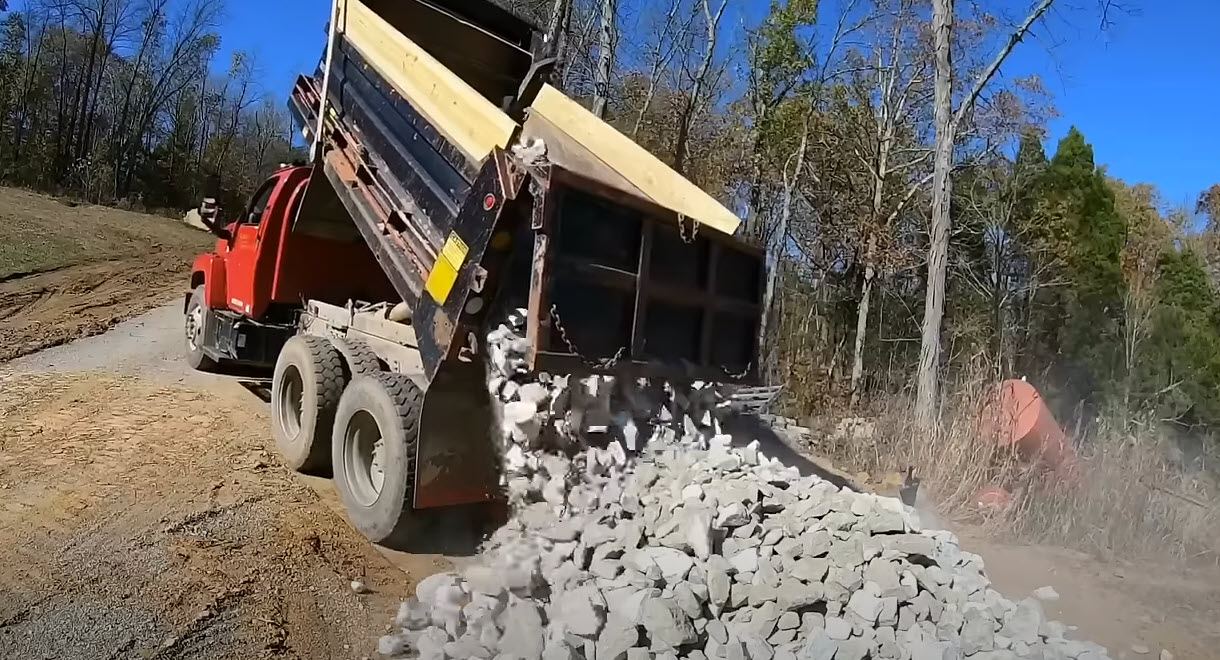Rock Trucking Servicesin Troy MI
Rock Trucking Solutions for Safe and Timely Delivery
We Are Locally Owned & Operated For Over 37 Years
Contact Us Today!
We Serve Businesses In And Around The Following Cities:
About Rock Trucking Services
Introducing Rock Trucks in Troy: Revolutionizing Commercial Properties
The foundation of any infrastructural project on a commercial property is defined by the quality of materials and equipment used. One such equipment playing a crucial role in construction, landscaping, and multiple other industries is a Rock Truck. Rock Trucks, especially in the dynamic and thriving city of Troy, prove to be indispensable when it comes to handling and moving large quantities of rocks, soil, and other materials. With cutting-edge technology and robust design, these machines come forth as an efficient solution to rock hauling challenges, shaping up buildings and landscapes that redefine the commercial realms of the city.
Riding Through The Detailed Process
Understanding the process of rock hauling aids in comprehending the significance of Rock Trucks in a broader context. Essentially, these trucks are heavy-duty vehicles designed to carry heavy loads – mostly rocks, gravel, and dirt – from point A to B and are typically used in large commercial projects. Companies like D&J Contracting specialize in providing rock hauling services, featuring a fleet of Rock Trucks operated by experienced drivers.
The process starts with loading up the Rock Truck: The truck is precisely driven to the site where the rocks or material are piled up. For picking up loose rock, a loading device like an excavator is commonly used. Once the truck is loaded, it moves to the intended unloading spot, which can vary from a landfill, a construction site, or a landscaping project. Upon reaching the destination, the hydraulically-operated dumping bed is lifted to unload the rocks or material conveniently.
The Undeniable Benefits of Rock Trucks
Strengthening the backbone of Troy’s commercial properties, Rock Trucks bring along numerous benefits. Besides obvious advantages like transporting heavy loads, their economic efficiency and time-saving capabilities play an immense role in scaling productivity of commercial projects.
Rock Trucks can carry enormous quantities of material in one run, which simplifies the logistical aspect of any construction project. They’re designed to navigate even the harshest terrains, ensuring that the work progresses without interruption. By utilizing Rock Trucks, business owners ensure the completion of their projects on time, stepping ahead with the rhythm of Troy’s progressive economy.
For instance, a business in Troy working on a new commercial property could gain considerably by contracting with D&J Contracting for their rock hauling services. Not only is the rock materials transport ensured, but the project’s pace is also maintained, guaranteeing the project’s timely completion. Consequently, it leads to cost-effectiveness in contrast to traditional transportation methods.
Real-world Applications Surpassing Boundaries
Companies that provide rock hauling services – for example, D&J Contracting – cater to a broad range of industries across Troy. Commercial construction, road construction, landscaping projects, and various other sectors heavily rely on Rock Trucks for their operations.
Focusing on commercial properties, landscaping projects frequently require large quantities of rocks to create unique landscapes. Hiring a professional rock hauling service provider not only helps in sourcing the quality materials but also timely transportation, paving the way for expedited project completion.
Similarly, commercial construction projects often involve vast amounts of excavation – a process generating a significant amount of rock and soil. These materials need to be removed from the site to make way for the construction process. With the assistance of a rock truck, such formidable tasks are made manageable.
Troy’s dynamic commercial properties’ skyward journey is testament to the professional acumen of companies like D&J Contracting, which plays an essential role by providing quality rock hauling services.
Charting the Path Forward
As we delve deeper into the heart of Troy’s commercial properties and the promising growth, it becomes evident how integral tools like Rock Trucks are in shaping its landscape. Backed by companies like D&J Contracting, it’s not just about moving rocks but more about building foundations for the city’s future.
In conclusion, let’s reflect on the impact and benefits of rock trucks on commercial properties in the city of Troy. From time efficiency to cost-effectiveness, and further to the wide-scale applications across industries, it’s clear that the benefits of rock hauling are manifold. Hence, incorporating such services becomes a strategic decision, critical to successful project completion.
Consequently, it’s worth considering how a partnership with a reputable, seasoned rock hauling service provider, such as D&J Contracting, could make a significant difference to any commercial project. The journey to constructing a magnificent commercial edifice in Troy starts with a robust rock truck.
Rock Trucking Services Gallery


Call Us Today to receive your Free Quote for
Rock Truck in Troy
Serving: Troy, Michigan

About Troy, Michigan
The earliest recorded purchases of land in what was known as Troy Township occurred in 1819. A couple of years later, a settlement known as Troy Corners was established due to Johnson Niles buying 160 acres in the region. The area is currently the north-central area of Troy. In 1827 Troy Township was established. In 1955, Troy was officially incorporated primarily as a strategy for preventing border cities from taking more land. This also helped to establish more robust city services for Troy residents, whose numbers increased rapidly during this time due to Detroiters fleeing the city for the surrounding suburbs.
It was named after Troy, New York and the ancient city of Troy as many of the early settlers, as in much of Michigan, originated from New York.
According to the United States Census Bureau, the city has a total area of 33.64 square miles (87.13 km), of which 33.47 square miles (86.69 km) is land and 0.17 square miles (0.44 km) (0.51%) is water.
| Census | Pop. | Note | %± |
|---|---|---|---|
| 1960 | 19,402 | — | |
| 1970 | 39,419 | 103.2% | |
| 1980 | 67,102 | 70.2% | |
| 1990 | 72,884 | 8.6% | |
| 2000 | 80,959 | 11.1% | |
| 2010 | 80,980 | 0.0% | |
| 2020 | 87,294 | 7.8% | |
| 2023 (est.) | 87,339 | 0.1% | |
| U.S. Decennial Census 2018 Estimate |
|||
According to a 2018 estimate, the median income for a household in the city was $96,864, and the median income for a family was $113,640. Males had a median income of $72,005 versus $52,365 for females. The per capita income for the city was $46,664. About 5.1% of families and 7.2% of the population were below the poverty line, including 6.7% of those under age 18 and 6.1% of those age 65 or over.
As of the census of 2020, there were 87,294 people, 33,822 households, and 24,300 families living in the city. The population density was 2,609.9 inhabitants per square mile (1,007.7/km). There were 34,953 housing units at an average density of 1,044.9 inhabitants per square mile (403.4/km). The racial makeup of the city was 62.2% White, 4.0% African American, 0% Native American, 27.3% Asian, 1.2% from other races, and 5.1% from two or more races. Hispanic or Latino residents of any race were 2.2% of the population.
There were 33,822 households, of which 35.4% had children under the age of 18 living with them, 60.1% were married couples living together, 8.3% had a female householder with no husband present, 3.4% had a male householder with no wife present, and 28.2% were non-families. 23.2% of all households were made up of individuals, and 10.1% had someone living alone who was 65 years of age or older. The average household size was 2.56 and the average family size was 3.05.
The median age in the city was 43.9 years. 20.7% of residents were under the age of 18; 8.8% were between the ages of 18 and 24; 32% were from 25 to 44; 28.6% were from 45 to 64; and 19.7% were 65 years of age or older. The gender makeup of the city was 50.5% male and 49.5% female.
| Race / Ethnicity (NH = Non-Hispanic) | Pop 2000 | Pop 2010 | Pop 2020 | % 2000 | % 2010 | % 2020 |
|---|---|---|---|---|---|---|
| White alone (NH) | 65,809 | 58,869 | 53,793 | 81.29% | 72.70% | 61.62% |
| Black or African American alone (NH) | 1,678 | 3,210 | 3,422 | 2.07% | 3.96% | 3.92% |
| Native American or Alaska Native alone (NH) | 105 | 124 | 108 | 0.13% | 0.15% | 0.12% |
| Asian alone (NH) | 10,713 | 15,439 | 23,788 | 13.23% | 19.07% | 27.25% |
| Pacific Islander alone (NH) | 18 | 1 | 9 | 0.02% | 0.00% | 0.01% |
| Other race alone (NH) | 79 | 125 | 312 | 0.10% | 0.15% | 0.36% |
| Mixed race or Multiracial (NH) | 1,373 | 1,502 | 2,908 | 1.70% | 1.85% | 3.33% |
| Hispanic or Latino (any race) | 1,184 | 1,710 | 2,954 | 1.46% | 2.11% | 3.38% |
| Total | 80,959 | 80,980 | 87,294 | 100.00% | 100.00% | 100.00% |
As of the census of 2010, there were 80,980 people, 30,703 households, and 22,443 families living in the city. The population density was 2,419.5 inhabitants per square mile (934.2/km). There were 32,907 housing units at an average density of 983.2 per square mile (379.6/km). The racial makeup of the city was 74.1% White, 4.0% African American, 0.2% Native American, 19.1% Asian, 0.6% from other races, and 2.0% from two or more races. Hispanic or Latino residents of any race were 2.1% of the population.
There were 30,703 households, of which 34.7% had children under the age of 18 living with them, 62.8% were married couples living together, 7.3% had a female householder with no husband present, 3.0% had a male householder with no wife present, and 26.9% were non-families. 23.4% of all households were made up of individuals, and 9.6% had someone living alone who was 65 years of age or older. The average household size was 2.63 and the average family size was 3.14.
The median age in the city was 41.8 years. 23.8% of residents were under the age of 18; 6.7% were between the ages of 18 and 24; 24% were from 25 to 44; 31.6% were from 45 to 64; and 13.8% were 65 years of age or older. The gender makeup of the city was 49.3% male and 50.7% female.
From the census of 2000, there were 80,959 people, 30,018 households, and 21,883 families living in the city. The population density was 2,413.9 inhabitants per square mile (932.0/km). There were 30,872 housing units at an average density of 920.5 per square mile (355.4/km). The racial makeup of the city was 82.30% White, 2.09% African American, 0.15% Native American, 13.25% Asian, 0.02% Pacific Islander, 0.36% from other races, and 1.82% from two or more races. 1.46% of the population was Hispanic or Latino of any race.
There were 30,018 households, out of which 36.9% had children under the age of 18 living with them, 64.5% were married couples living together, 6.0% had a female householder with no husband present, and 27.1% were non-families. 22.8% of all households were made up of individuals, and 7.8% had someone living alone who was 65 years of age or older. The average household size was 2.69 and the average family size was 3.23.
In the city 26.2% of the population was under the age of 18, 6.7% from 18 to 24, 29.8% from 25 to 44, 27.1% from 45 to 64, and 10.2% who were 65 years of age or older. The median age was 38 years. For every 100 females, there were 98.1 males. For every 100 females age 18 and over, there were 94.8 males.
From 1990 to 2000, of all of the municipalities in Oakland, Wayne, and Macomb counties, Troy had the highest numeric growth in the Asian population. It had 4,932 Asians according to the 1990 U.S. Census and 10,730 according to the 2000 U.S. Census, an increase of 5,798. The increase gave Troy the largest Asian-American population in the tri-county area, surpassing that of Detroit.
Troy uses the council–manager form of government, and thus is governed by a city council consisting of a mayor and six council members. The current mayor is Ethan Baker, who was elected to a four-year term on November 5, 2019. The city council appoints a City Manager, who manages the day-to-day operations of the city.
The City of Troy and City of Clawson on its southern border compose Michigan’s 41st District for State Representative. The district is currently represented by Padma Kuppa in the State House since 2019, and in the state Senate by Mallory McMorrow, since 2019. The district was previously represented in the State House by Martin Howrylak since 2013, and in the state Senate by Marty Knollenberg, since 2015. On the national level, Troy was part of the 9th district, represented by Joe Knollenberg from 1993 to 2009 and Gary Peters, who defeated Knollenberg in a highly publicized race in November 2008. Nationally, Troy is part of the 11th district, held by Democrat Haley Stevens.
Troy is the location of Walsh College, a business school, as well as branches of the University of Phoenix, Northwood University, Central Michigan University, Spring Arbor University, International Academy of Design and Technology, and Michigan State University.
There are seven school districts serving Troy; however, Troy School District serves the majority of the city limits. The district has multiple elementary schools, four middle schools, and two zoned high schools: Troy High School and Athens High School.
Three school districts have sizable portions of territory in Troy and operate at least one elementary school within the city: Avondale School District, in the north and northwestmost portion of the city; Birmingham City School District, in the southwestmost portion; and Warren Consolidated Schools, in the southeast, which operates Susick Elementary within the city. In addition, two other school districts are located in part in Troy but have no schools within the city limits: Bloomfield Hills School District, with a portion of the northwest part of the city, and Royal Oak School District, which has a very small portion of the southern part of the city. Finally, a small area of commercial property also in the south lies within the borders of Lamphere Public Schools
The Troy School District also hosts the eastern campus of the International Academy. Private schools include Bethany Christian School, Brookfield Academy, Oakland Children’s Academy, St. Mark Christian Academy and Troy Adventist Academy.
Call Us Today to receive your Free Quote for
Rock Truck in Troy
Related Services in Troy, Michigan
We Serve Businesses In The Following Zip Codes:
48007, 48015, 48021, 48026, 48035, 48036, 48038, 48042, 48043, 48044, 48045, 48046, 48047, 48048, 48050, 48051, 48066, 48071, 48080, 48081, 48082, 48083, 48084, 48085, 48088, 48089, 48090, 48091, 48092, 48093, 48098, 48099, 48225, 48230, 48236, 48310, 48311, 48312, 48313, 48314, 48315, 48316, 48317, 48318, 48397